






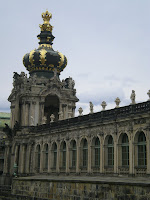









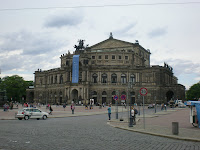








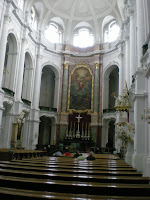









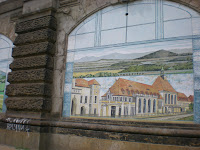





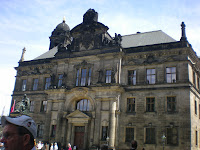







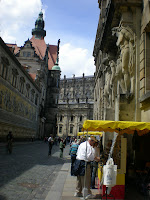








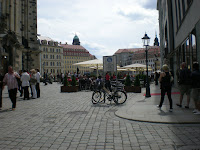


Left at 5:00 AM this morning for our Seminar in Freiberg. It was a five hour trip so we checked into our Bed and Breakfast. It was a really cute place and the bed was actually a Tempurpedic. I knew this would be a good nights sleep for me and Elder Walters, but first we had to take a look around the place. We shared a bathroom with another couple but that was alright. Can't have everything just perfect. We stashed all the computers' in the room and drove into Dresden, a mere 25 miles away. After the Berlin Wall came down, West Germany began rebuilding Dresden and it really shows. We approached the beginning of our journey by walking through the Kronentor which stands as a symbol for Dresden's identity. The City was totally destroyed in the War and all buildings were burned to the ground. 35,000 people lost their lives here. Allot of the structures are being rebuilt with citizen donations.
The center of town is amazing with lots of art museums as well as the art academy which has a glass cupola and on top, the Fama, better known as the lemon squeezer. It strangely resembles the Statue of Moroni on the temple, except this is a girl with wings, however, it is gold, the angel is standing on a gold ball and she is blowing a horn just like Moroni's. It is beautiful.
The architecture of the buildings are done in Italian Renaissance period. Everything seemed to be laid out so it fit just perfectly. We walked from one interesting place to another. Statues and fountains everywhere. We found the famous Frauenkirche. This church is to the Germans, what Saint Peter's Basilica is to the Italians. It is a true protestant project. Totally destroyed in WWII, the town's people had a choice, preserve it as is for a memorial to the War, or rebuild it. They chose to rebuild and it is breathtaking. In the front is a statue of Martin Luther, the Reformer.
Next we walked to the Theater Platz, where the Semper Opera House is. This is where most of the City walk ways are that lead to the other historic sites. This runs along the beautiful Elbe River. We enter next into a central plaza which has on one side the Hofkirche or S.S. Trinitatis Cathedral. Outside are huge figures of Saints bearing witness to the Catholic church built by King August III, the son of August the strong. Unlike the Frauenkirche which was a Protestant church, the Hofkirche was built because the Catholic court wanted to design a better place to worship in. Of the two churches, I believe the Frauenkirche is the more beautiful. In 1737 an Italian architect designed it in the late Baroque style. Inside is a crypt which holds the heart of August the Strong. According to legend, the heart begins to beat whenever a pretty girl walks past. The huge altar painting was done by Raffael Mengs and depicts the ascension of Christ. Both August the Strong and his wife Maria Josepha had a love for Italian art, which is plentiful throughout the church.
As we rounded one street, we see a huge wall frieze made of Meissen China tiles. It represents the triumphal procession of the Wettin Princes. It takes up almost an entire side of a street. Some of the other beautiful buildings we saw were the numerous museums with lots of Italian art pieces. The Yenidze is a glass dome which is designed as an Oriental mosque. It was build as a tobacco factory and supplied 1/3 of the German cigarettes. The Zwinger is a beautiful court of gardens, fountains and statues. It was completed for the wedding of August the Strong and his bride Maria Josepha in 1719. It is a masterpiece of Saxon Baroque architecture. The Johannellm which houses the famous painting Canaletto by Bernardo Bellatto. The Georgenbau which is is adorned with the Georgentor or Strong man statue. These are huge warriors on each side of the walk way. I think my sons would appreciate the art work. Bruhl Terrace is a place you could just sit and relax for hours. It is built where the old Dresden fortress wall was. The spacious flight of steps are flanked by sculptures depicting the four times of the day. The Agustus Bruke is the bridge crossing the beautiful Elbe River. Then there is the Langer Gang which is near the beautiful Furstenzug tile. This is a row of buildings with Tuscan colums. A tournament area and a horse pond are part of these buildings. Inside is an extensive gun collection of August the Strong. Last is the Dresden Market Platz which is the center of town. The pictures speak for themselves.
No comments:
Post a Comment